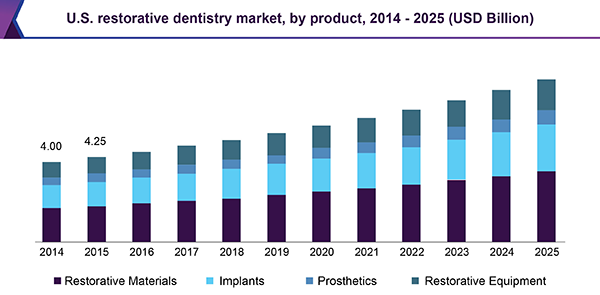 The global restorative dentistry market is expected to grow to $25.9 billion (£19.2 billion) by 2025, new research has found.
The global restorative dentistry market is expected to grow to $25.9 billion (£19.2 billion) by 2025, new research has found.
The report, published by Grand View Research, pointed to the growing number of dental practices and corporate practices moving into the sector as one of the main reasons for the compound annual growth rate (CAGR) of 6.7%.
Some of the other reasons included the growth in digital dentistry and increased demand from patients for cosmetic treatments.
‘The growth of the global implant market should be welcome news for dentists and patients alike,’ Guy Hiscott, editor of Implant Dentistry Today, said.
‘An expanding market means more space for competition, bringing with it more innovation, reduced costs for all concerned, and most importantly, a greater understanding of how dental implants fit into the landscape of modern, appropriate and technologically-advanced dentistry.
‘Dental implants may be the best way to replace missing teeth but to be used effectively they require training and experience from the clinician, and a commitment to maintaining them from the patient.’
Largest growth areas
Europe has dominated the restorative dentistry market recently, with the presence of several key manufacturers in this area as one of the main reasons.
The Asia-Pacific region is expected to experience the largest growth over the next seven years, due to its increasing population, rising number of dental practices, growing awareness of treatments amongst dentists and patients, and a growing geriatric population.
A steep increase in the number of dental colleges, students, and hospitals, the report claims is also likely to ensure a growing number of dental practices, which in turn is expected to drive the growth of the restorative dentistry market in the Asia Pacific region.
‘The growth of the global market also highlights a need for suppliers and manufacturers to rise to the challenge of educating dentists and patients about this wonderful, but undeniably demanding treatment, modality,’ Guy continued.
‘The elephant in the room is, of course, peri-implantitis, and without a proper understanding of implant dentistry, more implants can all-too-easily become more cases of this destructive condition.
‘But there is no reason for peri-implantitis to be the epidemic waiting in the wings that some claim.
‘It is therefore crucial that we all look at this market growth as an opportunity to spur our understanding of implant dentistry forwards together – and ensure everyone can benefit from implant dentistry for many years to come.’

Let’s block ads! (Why?)





